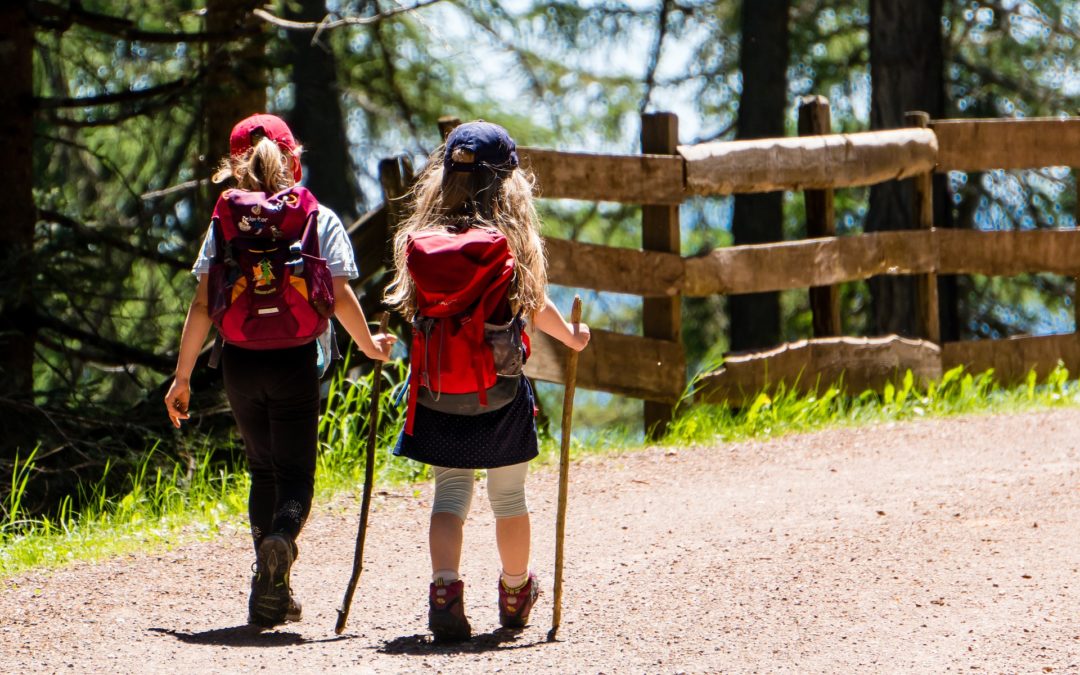Walking to school has many benefits for Alaska kids and their communities. It can help students move more and do better in school. Walking also can reduce traffic in neighborhoods, and that can make it safer and easier to get to school.
“I walk my son to and from his elementary school every day,” said John Angst, father of a Rabbit Creek Elementary School student in Anchorage. “We always really look forward to our walks to and from school. It’s a great way to get going in the morning and a nice way to unwind after school. It gives us a chance to talk without the distractions of TVs, phones, and computers.”
Move more, feel better and perform better
Walking to school helps children get closer to the recommended 60 minutes of daily physical activity that kids need for the best health. Daily activity improves growth and development, as well as heart health. It makes muscles and bones stronger. A walk to and from school likely doesn’t take an hour, but the benefits add up over time.
“Walking to school provides students an opportunity to activate their bodies and brains in preparation for a great start to the school day,” said Melanie Sutton, curriculum coordinator for the Anchorage School District Health and Physical Education Department.
An hour of daily activity might sound like a lot, but it doesn’t have to happen all at once. The Physical Activity Guidelines for Americans say every bit of activity counts — no matter how short. That means kids can add the time it takes to walk to and from school to other activities, like the minutes they spend being active at recess, in gym class, or playing with their friends and family.
Walking to school could help children at school, too. The national guidelines say that regular activity improves memory, attention, and performance in the classroom. Kids who get regular physical activity can learn better and improve their grades.
Promoting safety for walkers
Simple strategies make it safer for children to walk to school. Vision Zero Anchorage is an initiative to eliminate traffic deaths and serious injuries for all road users. Communities like Anchorage are making it safer to walk by enforcing low-speed limits in school zones, using marked or signaled street crossings, designing safe and convenient sidewalks or paths between neighborhoods and schools, and adding street lighting.
Drivers can help keep walkers safe by not driving distracted.
“When driving, it’s much safer for everyone if we put down our phones, and leave the controls, displays, and navigation alone,” said Dawn Groth, physical activity and nutrition specialist with the State of Alaska. “Let’s pay attention to what is going on around us.”
During recent school years, the Rabbit Creek Elementary School PTA in Anchorage called for a cell phone ban while driving to protect their students from distracted drivers. This led to similar requests from other local parents, teachers, and students. As a result, during the summer of 2019, Anchorage passed an ordinance making it illegal to drive in active school zones or grounds while talking on a hand-held mobile communication device, such as a cell phone, smartphone, tablet or any similar device. School zones where the speed limit is always 25 MPH or less are active between 6 a.m. and 9 p.m. Other school zones are active when school zone lights are flashing. Parents picking up their kids can use their devices once their car is parked. The penalty for using a cell phone in a school zone is a $500 fine.
Take steps to keep children safe
Everyone can help ensure children get to and from school safely.
Drivers:
- Do not use your smartphone or device while driving, including while stopped at a light or stop sign.
- Pay attention. Look for and stop for children.
- Slow down, especially in school zones, intersections and places kids walk and play.
- Leave the controls, displays, and navigation in your car alone.
- Drink your coffee or do your grooming when you reach your destination.
- Do not drive under the influence of drugs or alcohol.
Parents:
- Role model good driving habits.
- Ask children who are walking to put away mobile devices that can distract them.
- Put reflective stickers or materials on outer clothing and bags of children.
Kids:
- Walk on sidewalks and use crosswalks. If no sidewalk is available, walk facing oncoming traffic.
- Wear blinking lights.
- Always look left, right, then left again before crossing any street.
For more information on ways to promote safe walking to school, visit https://www.transportation.gov/mission/health/Safe-Routes-to-School-Programs.
Submitted by Alaska Department of Health and Social Services Play Every Day campaign to help Alaska children grow up at a healthy weight and encourage families to be physically active and choose healthy drinks. For more information, visit www.playeveryday.alaska.gov

